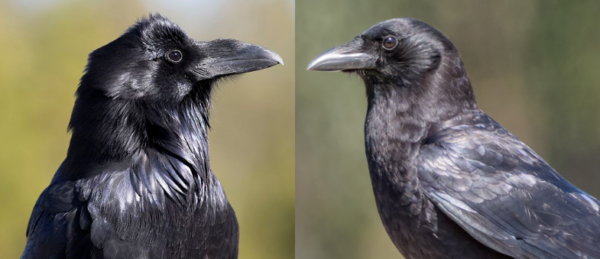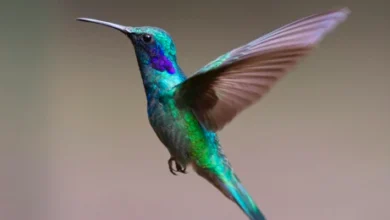Crow vs Raven: Understanding the Differences Between These Intelligent Birds

Introduction to Crows and Ravens
Crows and ravens, crow vs raven both belonging to the Corvidae family, are often noted for their striking intelligence and adaptability. These birds are found in various habitats across the globe, displaying remarkable problem-solving skills and social behaviors that have fascinated researchers and bird enthusiasts alike. Their significance transcends ecological contributions, as they have been revered, demonized, and symbolized in literature and mythology across diverse cultures.
From ancient Egypt, where they were associated with the afterlife, to Norse mythology, in which they are linked to the god Odin, crows and ravens have captured the human imagination for centuries. In crow vs raven many cultures, these birds symbolize wisdom, mystery, and sometimes bad omens. However, their ecological roles are equally important. Crows and ravens are scavengers, helping to maintain healthy ecosystems by feeding on carrion and waste. Additionally, their foraging behavior promotes seed dispersal, facilitating plant growth and maintaining biodiversity.
Distinguishing between crows and ravens is crucial for various reasons, including their biological differences, behaviors, and specific environmental requirements. While they may appear similar at first glance, subtle differences in size, vocalization, and flight patterns can aid in their identification. For example, ravens are generally larger than crows and possess a distinct wedge-shaped tail, whereas crows have a fan-shaped tail. Understanding these differences not only enriches our knowledge of avian biology but also enhances our appreciation of the roles these birds play in our environment.
In summary, the significance of crows and ravens in various cultures, paired with their essential roles in ecosystems, highlights the importance of recognizing the distinctions between them. As we delve deeper into the characteristics that set these intelligent birds apart, we will crow vs raven discover more about their behaviors, social structures, and ecological contributions.
Physical Differences: Size, Color, and Features
The crow and raven, both members of the Corvidae family, exhibit distinct physical traits that set them apart. One of the most noticeable differences is their size. Ravens are generally larger, measuring crow vs raven between 24 to 27 inches in length, while crows are smaller, ranging from 14 to 20 inches. This size variation can be surprising, particularly for those who may confuse the two birds in the wild.
Color also plays a significant role in distinguishing between these intelligent birds. Although both crows and ravens possess glossy black plumage, ravens often exhibit a slightly iridescent sheen, giving them a more lustrous appearance. Additionally, sunlight may reveal hints of blue or purple in the feathers of a raven, whereas crows typically appear a more uniform black. This variation in appearance can be crucial for bird watchers and enthusiasts attempting to identify these species in their natural habitat.
Unique features further differentiate the two birds. The shape of the beak provides a clear distinction; ravens have larger, more robust beaks that curve slightly downward, while the beak of a crow is generally straighter and more slender. When it comes to tail feathers, a raven’s tail exhibits a wedge-like shape that is easily recognizable during flight, contrasting with the fan-shaped tail of a crow. Observing crow vs raven the flight patterns can also aid in identification, as ravens tend to soar and glide more than crows, which are characterized by a rapid, flapping flight style.
Understanding these physical differences is essential for anyone interested in these remarkable birds. By recognizing the size, color, and distinctive features of crows and ravens, one can crow vs raven cultivate a deeper appreciation for their behaviors and habitats in the avian landscape.
Behavioral Differences: Communication and Social Structure
Crows and ravens are known for their remarkable intelligence, which manifests in various behavioral traits, particularly in their communication and social structures. Both belong to crow vs raven the Corvidae family, yet their differing interactions and social behaviors are significant enough to distinguish one from the other.
Communication is a fundamental aspect of the lives of both crows and ravens. Crows typically utilize a range of vocalizations to convey messages within their groups. Their calls can vary significantly, reflecting their mood or the specific situations they encounter. For instance, crows often use a “caw-caw” sound as an alarm signal, alerting other crows to potential dangers. Ravens, on the other hand, are noted for their deeper vocalization and a broader repertoire. They often produce a croaking sound and can mimic other birds or even human noises, indicating their adaptability and intelligence. This complexity in vocalization reflects not only their intelligence but also their need to communicate effectively within changing environments.
When it comes to social structure, crows typically exhibit a more communal lifestyle, often forming large, cohesive groups known as “murder” when foraging or roosting. This social organization fosters cooperation and protection among members, which can involve collective mobbing behavior to deter predators. Conversely, ravens tend to be more solitary or pair-bonded, often seen in smaller family units. Their social interactions are characterized by strong bonds between mates, which can crow vs raven last for years, while also engaging in playful antics that suggest a complex social understanding.
The differences in communication styles and social structures between crows and ravens highlight their unique adaptations to their environments. Each bird’s behavior reflects its intelligence and ability to thrive in diverse habitats, ensuring their survival and success.
Habitat and Distribution: Where to Find Crows and Ravens
Crows and ravens, both crow vs raven belonging to the Corvidae family, exhibit remarkable adaptability to various environments. These intelligent birds can be found in a wide range of habitats across the globe, though their specific distributions can vary significantly. Crows typically thrive in a wider array of habitats, including urban areas, open fields, forests, and wetlands. They have demonstrated exceptional resilience to human activities, often becoming a common sight in city parks and suburban neighborhoods.
Ravens, on the other hand, tend to prefer more remote and rugged environments. They are often found in mountainous regions, forests, or deserts, showcasing a preference for locations that offer ample nesting sites and a reliable food supply. Unlike crows, ravens are less likely to inhabit densely populated urban areas, although they can sometimes be seen in smaller towns or areas near human habitation where food sources are available.
The overlap between the habitats of crows and ravens can create interesting interactions, particularly in regions where their ranges meet. For instance, in certain parts of North America, both species can coexist, displaying distinct behaviors and foraging strategies. Urbanization crow vs raven significantly affects the habitats of both birds. Crows have adapted remarkably well to city life, often scavenging for food in human-dominated landscapes, while ravens maintain a more cautious approach, selecting locations on the outskirts where they can still find suitable nesting grounds and avoid excessive disturbances.
In conclusion, understanding the habitats and distribution of crows and ravens reveals important insights into their ecological roles and adaptability. While crows prominently crow vs raven thrive in urban settings, ravens favor wilder regions, illustrating the diverse strategies these intelligent birds employ to survive alongside human development.
Diet and Feeding Habits: What Do They Eat?
Crows and ravens, both members of the Corvidae family, exhibit remarkable adaptability when it comes to their diets and feeding habits. Although they share some similarities in their food preferences, distinct differences arise due to their behavioral nuances and environmental factors. Generally, these intelligent birds are omnivorous, meaning they consume a wide variety of food sources that range from plant matter to small animals.
Crows typically have a more generalized diet, often seen foraging for seeds, fruits, insects, and small vertebrates. They exhibit opportunistic feeding behavior, enabling them to thrive in urban environments where human waste provides a significant food source. Crows are known to scavenge and will often rummage through garbage or steal food from other animals, showcasing their crow vs raven cunning and resourcefulness.
Ravens, on the other hand, tend to hunt in pairs or groups, allowing them crow vs raven to take down larger prey compared to crows. Their diet can include small mammals, birds, and carrion. Ravens are also known to cache food; they will hide surplus food items for later consumption, demonstrating their impressive memory and foresight in food management. Their adaptability in various habitats, from forests to mountainous regions, allows them to gather diverse food sources that fit their crow vs raven nutritional needs.
Both crows and ravens employ unique foraging techniques. Crows are adept at using tools, such as sticks, to extract insects from crevices, while ravens, displaying problem-solving capabilities, demonstrate an ability to manipulate their environment to access food. These feeding habits not only highlight their intelligence but also reinforce their roles as crucial components in their ecosystems, controlling populations of pests and aiding in the decomposition of organic matter. Understanding the dietary differences between crows and ravens provides insight into their behavioral ecology and social dynamics.
Cultural Significance: Myths and Symbolism
Crows and ravens have long captivated human imagination, appearing frequently in mythology, literature, and folklore. These birds are often imbued with rich symbolic meanings that vary across cultures and historical contexts. For instance, in many Indigenous cultures of North America, the raven is regarded as a creator or a trickster, symbolizing transformation, intelligence, and change. Legends crow vs raven often portray the raven as a pivotal character that challenges the status quo and brings light or knowledge to humanity.
In contrast, crows are frequently associated with omens and are considered messengers between the living and the spiritual realms in various traditions. For example, in ancient Celtic lore, the crow is associated with the goddess Morrigan, who embodies war and fate, reflecting the bird’s connection to death and the supernatural. The perception of these birds often oscillates crow vs raven between wisdom and misfortune, rendering them complex symbols within cultural narratives.
Literature, too, has utilized the crow vs raven distinction to convey different emotional and thematic elements. Edgar Allan Poe, for instance, famously featured the raven in his poem “The Raven,” using the bird as a symbol of loss and mourning, while crows have been depicted in other literary works as clever and resourceful creatures, capable of outsmarting human adversaries.
Folklore across various cultures often embodies the dichotomy found in the crow vs raven discussion. In Asia, for example, the crow is a popular symbol of fertility and family, revered in some traditions as a protective figure. Meanwhile, in other societies, the raven’s association with dark omens persists, highlighting the dual nature of these avian symbols. Such varied interpretations emphasize how crows and ravens transcend mere biological distinctions, reflecting deep cultural beliefs and narratives that enrich human understanding of these remarkable birds.
Conservation Status and Threats: Protecting Crows and Ravens
Crows and ravens, members of the Corvidae family, are renowned for their intelligence and adaptability. However, both species face several threats that jeopardize their populations and habitats. Habitat loss, driven by urbanization, agricultural expansion, and deforestation, poses crow vs raven a significant risk to these birds. As their natural environments diminish, crows and ravens are forced to adapt to human-altered landscapes, which can lead to increased conflict with humans and other wildlife.
Climate change further exacerbates the challenges faced by these avian species. Changes in temperature and weather patterns can disrupt food availability and breeding cycles, placing additional stress on their populations. Additionally, both crows and ravens face direct human interactions that can be detrimental, including vehicle collisions, poisoning, and hunting. These factors crow vs raven contribute to a complex array of challenges that threaten the long-term viability of crow and raven populations.
Current conservation efforts aim to mitigate these challenges through various initiatives. Organizations dedicated to avian conservation are focusing on habitat restoration projects, public education campaigns, and legislative advocacy to protect critical areas for crows and ravens. These efforts not only aim to preserve the existing populations of these birds but also to promote coexistence between humans and wildlife.
Individuals can also play a role in the conservation of crows and ravens. Simple actions, such as creating bird-friendly habitats in urban or suburban gardens, can provide secure places for nesting and feeding. Additionally, reporting sightings of injured or endangered birds to local wildlife authorities can contribute to conservation efforts. By promoting awareness and taking proactive steps, we can help protect these intelligent birds and ensure their survival in today’s changing world.
Fascinating Facts: Myths vs. Reality
Crows and ravens, often mistaken for one another, are two highly intelligent members of the family Corvidae. Widely featured in folklore and mythology, these birds are often associated with superstitions and misinterpretations that overshadow their remarkable capabilities. One common myth is that both crows and ravens are harbingers of doom or symbols of death. While they have crow vs raven been depicted in this light in various cultures, these interpretations do not reflect the true behaviors and ecological roles of these avian species.
In reality, crows and ravens play crucial roles in their ecosystems. Known for their problem-solving skills, they exhibit behaviors that rival those of primates in terms of intelligence. For instance, studies have shown that crows can use tools, such as sticks to extract insects from tree bark. Similarly, ravens have been observed engaging in complex social interactions, indicating a high level of cognitive function. They can even plan for future events, showcasing an advanced understanding of their environment.
Another misconception is that crows and ravens have similar calls. While both produce a variety of sounds, their vocalizations can be distinctly different. Crows typically have a “caw” sound, whereas ravens often emit a deeper, croaky “croak.” This vocal diversity reflects their adaptability in communication, which is imperative for their social structures.
Moreover, regarding their habitats, crows are more adaptable and can flourish in urban settings, often scavenging for food amidst human activity. In contrast, ravens prefer more secluded areas, such as mountains and wooded regions. By understanding these differences and debunking myths surrounding the crow vs raven debate, we can appreciate the intelligence and adaptability of these remarkable birds.
Conclusion: The Intriguing World of Crows and Ravens
In the realm of avian species, the crow vs raven debate is both fascinating and essential for enthusiasts and birdwatchers alike. Through this exploration of their distinctive characteristics, social behaviors, and habitats, we have uncovered how these two intelligent birds, while closely related, exhibit notable differences that contribute richly to their unique identities. Crows, typically smaller and with a more robust vocal range, contrast sharply with ravens, which possess larger dimensions and a characteristic wedge-shaped tail. Their divergence is not merely physical; their behaviors, habitats, and interactions with their environment further highlight their individual adaptations.
Moreover, understanding the crow vs raven dynamic contributes significantly to crow vs raven the appreciation of avian biodiversity and intelligence. Both species have demonstrated remarkable problem-solving skills and adaptability, making them subjects of interest not just in ornithology but also in ecological conservation efforts. As we delve deeper into their behaviors and roles within ecosystems, we underscore the necessity of recognizing their contributions to biodiversity. Protecting them ensures the ecological balance and the preservation of species with significant cultural and biological importance.
We encourage readers to observe these remarkable birds in their natural habitats. Whether in urban environments or rural landscapes, crows and ravens are often present, commanding attention with their intrigue and intelligence. By supporting conservation efforts and spreading awareness of their vital roles in our ecosystems, we foster a greater appreciation for these remarkable creatures. A deeper understanding of the differences between crows and ravens not only enriches our knowledge but also enhances our connection to the natural world, encouraging us to engage in efforts that crow vs raven support their survival and well-being.
You May Also Read This Dailytimenews.

